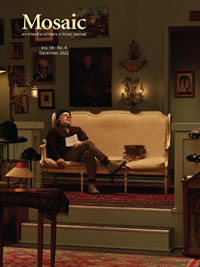Issue 54.4
Overview

General Issue
Published: December 2021
View the issue introduction or see the issue summary and contents below.
9 essays, totalling 176 pages
$24.95 CAD
Featuring the work of Rodney Graham on its cover and a discography by David Wisdom based on conversations with the late artist, Mosaic 54.4 includes essays on Nordic Noir, shame culture, heterotopia, trauma, celebrity, ontological angst, and dystopian athletics.
Vengeance Unbound: Henning Mankell’s The Man from BeijingDaniel McKay The Man from Beijing depicts ethnic Chinese workers on the US transcontinental railroad, a literary development that challenges the linguistic boundaries nominally associated with Asian American Studies. Of equal importance, I argue, is the way Mankell expands the cartography of Nordic Noir to encompass capitalism’s old-new frontiers in China (PRC). | |
Dynamics of Place: Foucault’s Heterotopias in Anne Michaels’s The Winter VaultMichael Greenstein This essay applies Michel Foucault’s theory of heterotopia or other place to Anne Michaels’s second novel, The Winter Vault, which repeatedly uses “place” as trope and topos. These “counter-sites” in her fiction contest communal and environmental displacements, and help to transform the otherness of her characters from loss to partial belonging. | |
The Differing Shame Cultures of Tony Williams’s Nutcase and Grettir’s SagaKathryn Hume Tony Williams’s Nutcase translates Grettir’s Saga into a modern setting. Saga shame- and social media shame cultures differ, particularly in what gives life to life. I draw on Beowulf, Grettir’s Saga, current criticisms of both, cultural theory, and other novels that build upon these earlier texts. | |
A Traumatic Reading of Maurya’s Passivity in Synge’s Riders to the SeaChu He This essay gives a traumatic reading of Maurya’s passivity. Traumatized by her sons’ deaths, Maurya develops PTSD symptoms including hyperarousal, intrusion, and constriction, and through keening she moves towards a recovery. Synge’s deft use of symbols, repetition, and imagery to stage trauma makes Riders a precursor to later trauma plays. | |
‘It’s More Terrible Not to Remember’: Alexievich and Women’s War LiteratureLaurie Vickroy Svetlana Alexievich’s text brings to light women veterans’ testimonies of lingering World War II traumas that challenge militaristic discourses. This study analyzes how Alexievich helped them claim their testimonial voices and provoked them to reveal traumatic effects and to contextualize and organize their words into trauma narratives. | |
‘We’ve Got to Believe Something’: Joyce Carol Oates and CelebrityDavid Rutledge In Broke Heart Blues and elsewhere, Joyce Carol Oates explores the psychology of celebrity worship. The adulation of celebrity is one way in which an American audience reaches for something to believe in. Oates shows how the audience creates the myths and illusions that it chooses to worship. | |
Ontology on the Shore: Murakami, Heidegger, and Narrative Confusion in Kafka on the ShoreDaniel Krahn This essay examines narrative confusion in Haruki Murakami’s Kafka on the Shore; it uses several ideas from Martin Heidegger’s Being and Time to examine the ontological angst surrounding the novel’s representation of selfhood and being. | |
Fit to Breed: Exercise and Sport in Women’s Speculative FictionKaren Ya-Chu Yang This essay examines Margaret Atwood’s The Handmaid’s Tale and Ursula Le Guin’s “The Matter of Seggri” as critiques of the segregative gendering of exercise and sport—especially, with regard to their portrayals of the dystopian ramifications of stringent communities where procreative competence is the sole criterion for determining bodily fitness. | |
Ten Songs that Came Up in Conversations with Rodney GrahamDavid Widom This discography was created by David Wisdom based on conversations with Rodney Graham. Mosaic is pleased to publish it here. |